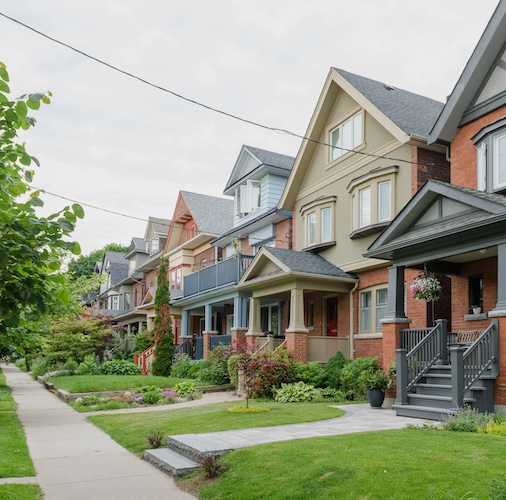A guide to real estate and housing market indicators
Contributed by Sarah Henseler
Nov 14, 2025
•9-minute read

Housing market indicators give us an idea of real estate trends across the country. Analysts use these indicators to predict the future of the housing market. As a buyer or seller, it’s important to note that many of these indicators directly affect supply and demand.
We’ll discuss some of the most important housing market indicators and why they matter, with expert commentary from Redfin Chief Economist Daryl Fairweather.1
Housing affordability
What it is: Definitions vary, but the Department of Housing and Urban Development (HUD) uses a guideline that housing is affordable if it costs no more than 30% of your monthly pretax income, including utilities.
Why it matters: Housing affordability levels make home buying accessible to potential purchasers or can lock them out of the market. There are various indexes that track home affordability. One of the more prominent ones comes from the National Association of REALTORS® (NAR).
The NAR index has a default weight of 100. If the number is higher than this mark, the median income is more than enough to afford the median cost of a home. If it’s lower than 100, the median income isn’t keeping pace with home prices. In the latest August 2025 data, the index stood at 100.5. Metro indexes complement this national number.
Ultimately, the percentage of income that should be spent on a mortgage depends on your personal financial situation. Always be aware of your other financial goals and your rainy-day savings funds.
Rental affordability
What it is: HUD again defines affordability as spending no more than 30% of your income, but the standard is applied to rental housing units. You may see these referred to as rental affordability indices (RAI).
Why it matters: Rental affordability can be a good indicator of how expensive it is to live in an area, even if you’re not looking to put down permanent roots. Again, the amount spent on rent depends on personal budgets, but 30% is often considered the dividing line between higher and lower affordability.
Supply and demand in real estate
As in many markets, supply and demand in the housing market are huge drivers of affordability. There are several metrics that we tend to look at.
Housing supply
What it is: Housing supply is the amount of inventory available on the market. The most useful metric in this area is often months of supply, which measures how many months it would take to sell the current housing stock at the current pace of sales.
Why it matters: More months indicate a buyer’s market, while fewer months favor sellers. While in recent years we’ve experienced lower housing inventory, there are signs that this may be changing, according to a new Redfin metric that estimates the number of buyers and sellers in an area.
“The most recent data shows that there are 35% more home sellers than buyers in the U.S. housing market, making it the strongest buyer’s market on record,” says Fairweather, the Redfin chief economist. “Florida and Texas are home to the strongest buyer’s markets: There are more than double the number of sellers than buyers in Miami, Austin, Fort Lauderdale, West Palm Beach, and San Antonio.”
Home sales
What it is: This is the number of sales taking place in a geographic region within a given time frame. There are also pending sales indicators that show homes under contract.
Why it matters: Home sales can be a useful indicator of movement in and out of a market. While these tend to be backward-looking, they can be an indicator of general market trends. The Census Bureau and HUD jointly released a report on sales of newly constructed homes, while NAR released one on existing homes.
The Redfin Data Center includes weekly and monthly data on both completed home sales and pending home sales in markets across the country.
Home prices
What it is: These indexes either look at home prices themselves or use a weighted average in comparison to a baseline to give directional trends. For example, Redfin tracks the median listing price; the Redfin Home Price Index measures pricing on repeat sales to show relative changes in prices over time.
Why it matters: If you’re a home buyer or seller, the home price you can expect to receive or offer is the bottom-line number. Together with individualized tools such as comparative market analyses conducted by real estate agents, this gives home buyers and sellers an idea of what to expect.
National homeownership rate
What it is: This looks at the percentage of homeowners in the U.S. who own their homes. According to Census Bureau data, the homeownership rate for Q2 2025 was 65%.
Why it matters: Generally speaking, when the economy is in a state where more people own their homes, it bodes well for affordability. More people who want to be homeowners are becoming homeowners.
Home building indexes
Builders are focused on profit margin to support their businesses. As such, they are only going to build when there’s a market to support the price they need to receive. While government housing projects don’t have the same monetary motive, plenty of private building indicates robust demand.
Housing starts
What it is: Housing starts track when ground is broken on new residential construction. Construction permits can also be a good advance indicator, but not all permits result in houses. Meanwhile, construction is also reported as complete, but by the time the home is built, it’s often spoken for.
Why it matters: “Housing starts are among the most closely watched forward-looking indicators in the residential real estate market because they reflect supply-side momentum, i.e. how many home builders are willing to greenlight projects given current cost and demand,” says Fairweather.
Simply put, more starts mean more supply, while fewer starts mean fewer units to go around. Starts were falling in the most recently available Census Bureau data from August 2025. It’s worth noting that this data is a bit older than usual due to the government shutdown still in effect at the time of this writing.
Fairweather suggests that builders are dealing with both supply issues and lighter macroeconomic effects.
“Builders are pulling back from both single-family homes and multi-family properties as construction costs rise, partly due to tariffs, and home buying demand remains soft,” she says. “On the apartment side, there has been a building boom over the last several years, and now builders are pulling back a bit as vacancy rates tick up.”
Construction spending
What it is: The Census Bureau tracks both public and private construction spending across the economy. It measures the cost of construction. Home buyers should pay particular attention to the residential construction figure in this report.
Why it matters: “Rising construction spending is an indicator of economic growth and a signal that builders and renovators feel good enough about the economy to commit money to home projects. It is also a strong predictor of local economic growth,” Fairweather said. “Metros with growing economies attract more residents, who require more housing.”
When builders have a surplus of housing, they may offer concessions such as free upgrades or temporary buydowns of mortgage rates.
The recent trend has been toward lower spending, but Fairweather sees reason for optimism.
“Residential construction spending is stagnant because home builders are cautious amid high mortgage rates and tepid home buying demand, along with the rising cost of labor and materials,” she said. “But it’s worth a reminder that builder confidence is improving, which may lead to more home building soon.”
She’s particularly optimistic about places like Florida and Texas.
NAHB survey
What it is: The National Association of Home Builders surveys its membership every month on current sales, expectations for the next 6 months, and traffic of prospective buyers. Numbers over 50 in the majority indicate greater market confidence, while numbers below 50 indicate market concern.
Why it matters: If builders are feeling more confident, they build more. Although overall confidence is currently in negative territory at 37 as of October 2025, expectations for the future have officially crossed the threshold into positive territory at 54.
“Housing starts could tick up in the coming months, as confidence among U.S. home builders posted its biggest increase in October in early 2024, with builders buoyed by declining mortgage rates,” said Fairweather.
Home loan origination
The number of successful mortgage originations, or new loans closed, can be an affordability indicator because it suggests people are generally finding it easier to get approved and achieve their goals in the current interest rate environment. There are a couple of reports we can look at to track this.
Total mortgage originations
What it is: The Federal Housing Finance Agency maintains the National Mortgage Database, which includes the total number of mortgages closed in the U.S. each year.
Why it matters: Purely knowing the volume of lending each year can help you see the kind of market it is. If people are getting more loans, that means people are finding financial conditions easier.
In 2024, 4.284 million mortgages were originated. This is up from 2023, when 4.015 million mortgages closed. Correlating that with the moves of the Federal Reserve, that’s reflective of a falling rate environment over the same time frame.
FHA originations
What it is: HUD maintains separate data on the number of FHA loans done on a monthly basis, as well as their characteristics.
Why it matters: FHA originations are good for first-time home buyers and people with past credit issues because they offer low down payments and more flexible guidelines. The trends in this report help provide people with more insight into the availability of mortgage financing for those with imperfect qualifications.Mortgage health indicators
There are indicators in the mortgage market that are also applicable to the broader economy as signs of strain. For example, if many are delinquent or going into foreclosure, it’s not only a harbinger of issues in the mortgage market, but it’s a sign that people are struggling because they tend to prioritize their house payment.
Mortgage delinquency
General mortgage delinquency refers to late payments. They start showing up on credit reports when people are 30 or more days late, which is when it’s visible to tracking agencies like the CFPB and FHFA.
Why it matters: While there is plenty of time at this point to either catch up or look into loss mitigation options, this is an early warning sign of how many consumers are having trouble making their mortgage payments.
Seriously delinquent mortgages
What it is: The NMDB and CFPB also maintain this database of mortgages that are 90 or more days behind in their payments.
Why it matters: This one is important because people are one month from foreclosure at this point. It’s a sign of the number of mortgages facing acute distress. As with the data that’s between 30 – 89 days late, these data points can be viewed at the state, county, or metro level.
Fairweather gave some insight into current trends in mortgage delinquency.
“The mortgage delinquency rate, which includes all loans that are at least one payment past due but aren’t in foreclosure, was 3.93% of all outstanding loans in the second quarter,” she said. “That’s down slightly year over year, and below the historical average of 5.21%. But note that serious delinquencies, loans that are 90 or more days past due, are rising, likely related to signs of weakness in the labor market and increasing delinquencies in other forms of debt, like credit cards.”
Foreclosure auctions
What it is: The number of foreclosure auctions gives an idea of the overall health of the housing market. It indicates when lenders move forward with repossessing homes and selling them.
Why it matters: Local sources may be able to give you more granular data, but at a more topline level, the real estate insights firm ATTOM™ tracks foreclosures at a state level, so you can get an idea of the health of the economy. If you’re a home buyer, you may be able to get a deal on a foreclosure, but they are sold as is.
Homeowner equity trends
Home equity is the value of a home after subtracting the outstanding mortgage balance. It’s not a perfect correlation, for reasons we’ll get into, but increases in equity can suggest that home values are rising.
Increase in equity
What it is: Increases in equity mean that, over time, the combined mortgage payments and increases in property value mean that you owe less on your loan relative to the value of the property.
Why it matters: “Rising equity builds wealth and buffers against volatility in other investments, while falling equity increases financial risk,” says Fairweather. “Plus, when homeowners have a lot of equity, they can use their house as a bank account, pulling out money via a HELOC or cash-out refinance.”
According to Redfin data, the U.S. housing market added $2.5 trillion in value in 2024, bringing the total to $49.7 trillion. That represents 5.2% year-over-year growth from the prior December. While it’s growing more slowly than markets where home values were rising faster on the back of low rates, equity levels are still extremely high.
Underwater borrowers
What it is: Being underwater on your mortgage means owing more on your home than it’s worth.
Why it matters: Homeowners can be underwater for a couple of reasons: Either they bought the home and haven’t been able to make the payments regularly since, or the property value has actually declined. Either way, many underwater borrowers can indicate an unhealthy housing market.
The bottom line: Optimize your home purchase with market insights
Understanding real estate markets can help you in a variety of ways, from determining how much you can afford to what you should offer. Other indicators can help you gauge the health of the economy and where you might find a good deal.
Supplementing this knowledge with the insight from a real estate agent on the ground can help you be the most informed home buyer possible. Ready to look into the mortgage? Apply online.
1 Rocket Mortgage is an affiliate of Redfin. You aren't required to use its lending services. Learn more at redfin.com/afba.Kevin Graham
Kevin Graham is a Senior Writer for Rocket. He specializes in mortgage qualification, economics and personal finance topics. Kevin has passed the MLO SAFE exam given to mortgage bankers and takes continuing education courses. As someone with cerebral palsy spastic quadriplegia that requires the use of a wheelchair, he also takes on articles around modifying your home for physical challenges and smart home tech. He has a BA in Journalism from Oakland University.
Related resources

8-minute read
How to start investing in real estate
Real estate investing can potentially create passive income and profit for investors. Learn more about how to make real estate investments.
Read more
5-minute read
These are the 6 top tax benefits of owning rental property
If you’ve invested in rental property, you may enjoy some tax benefits. Learn the top 6 tax benefits of owning rental property from deduction to depreciat...
Read more

8-minute read
Different types of mortgages and how they work
There is a home loan for everyone, but which type of mortgage is best for you? Use this article to understand the types of home loans and how they work.
Read more